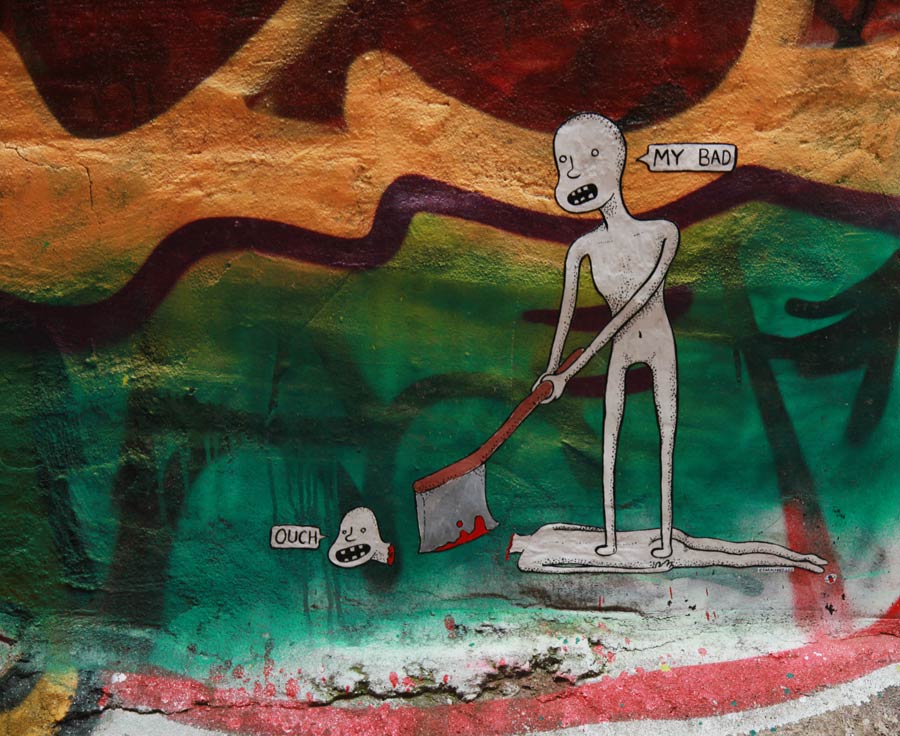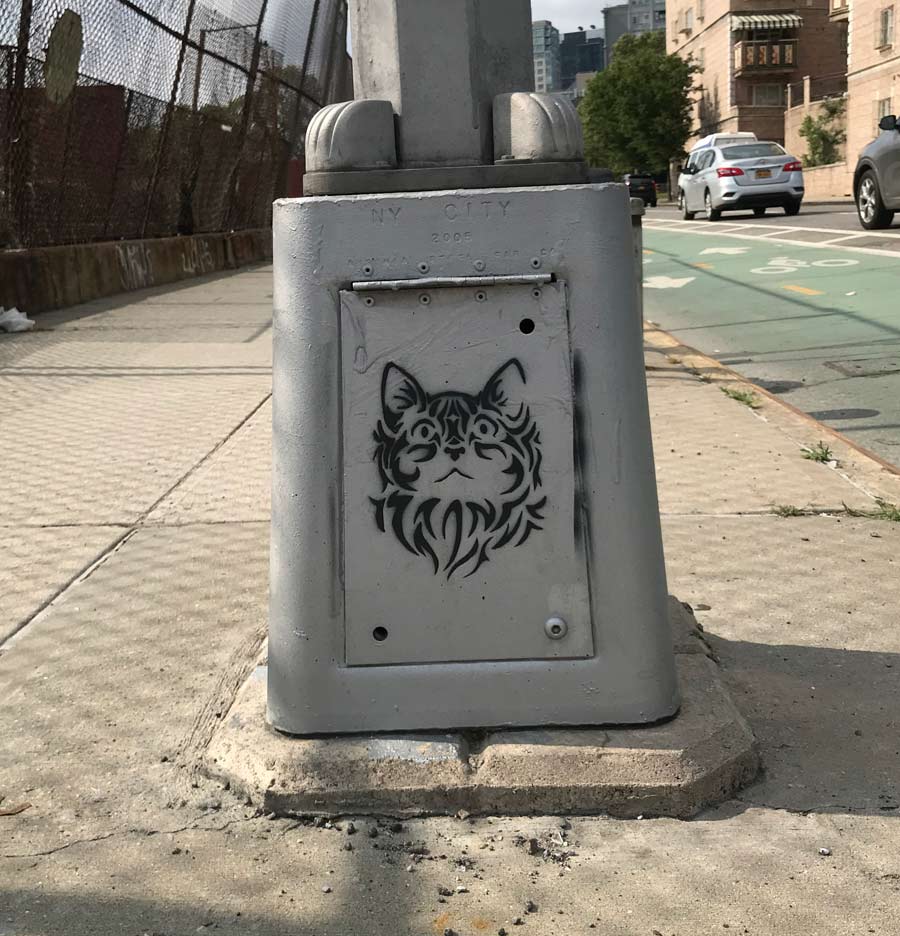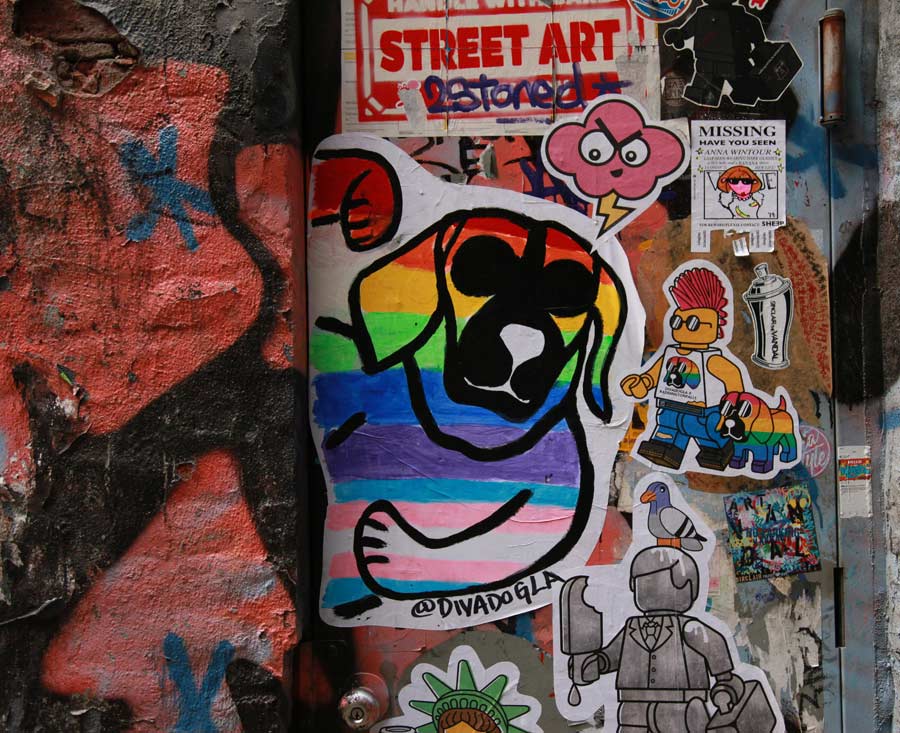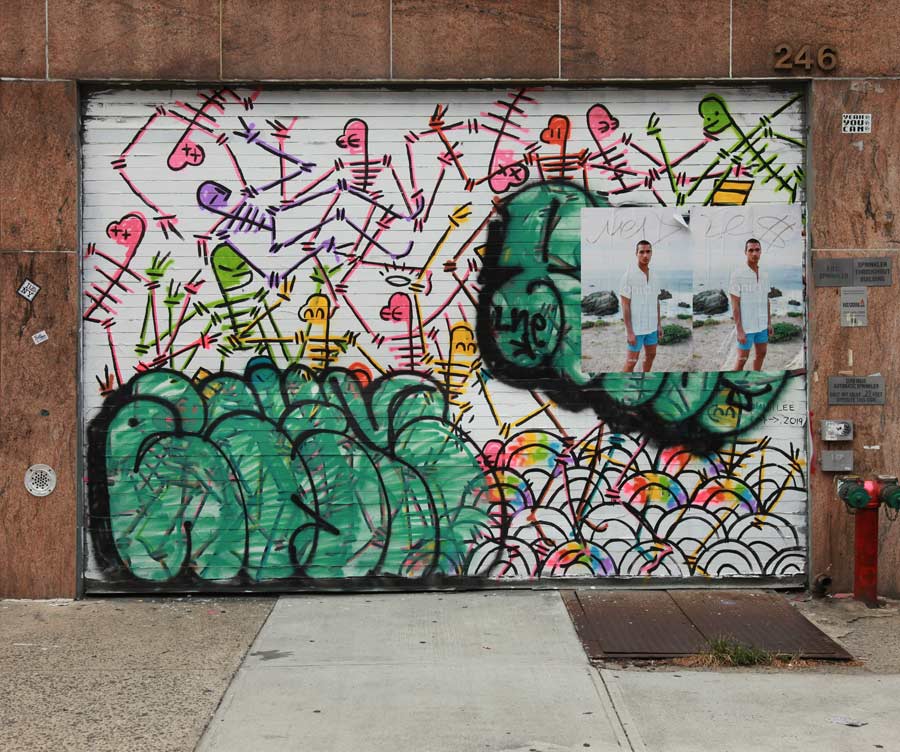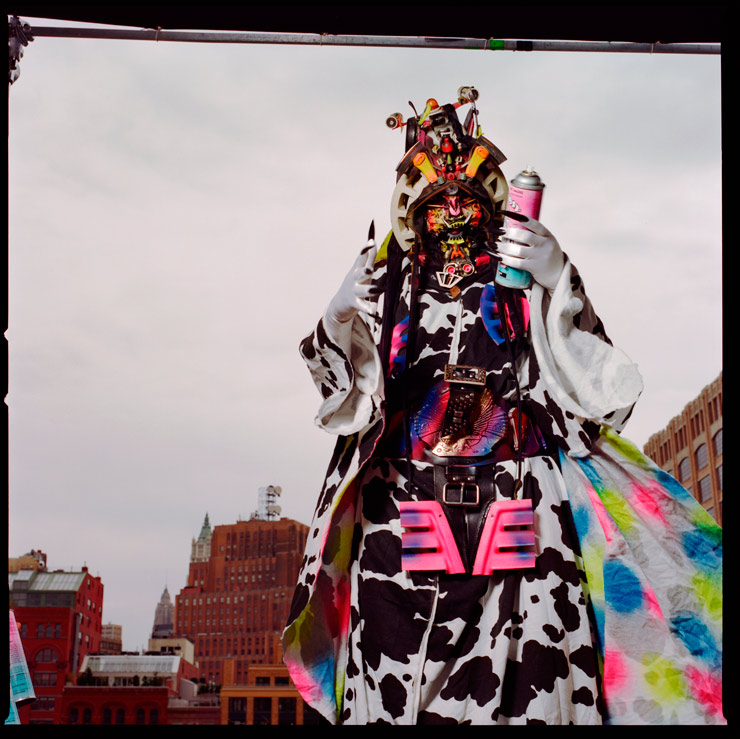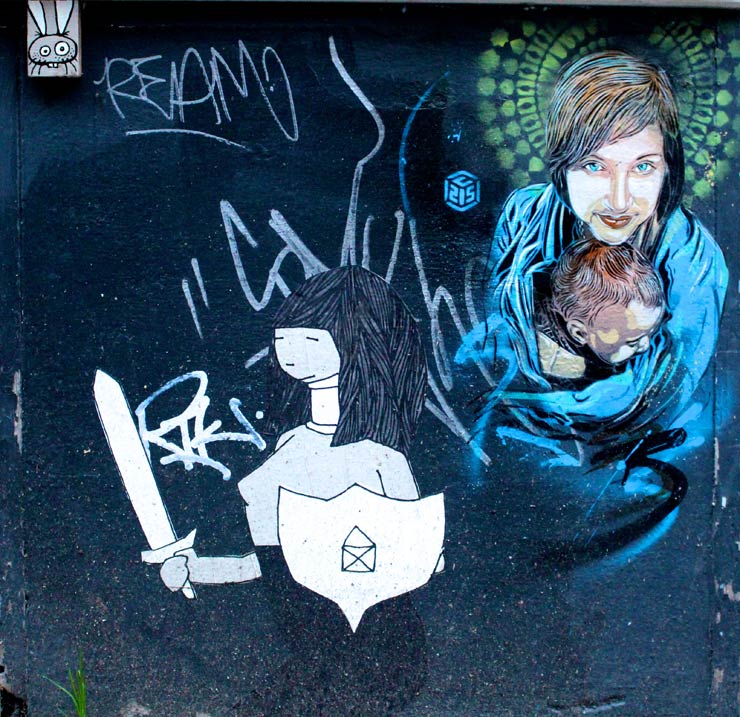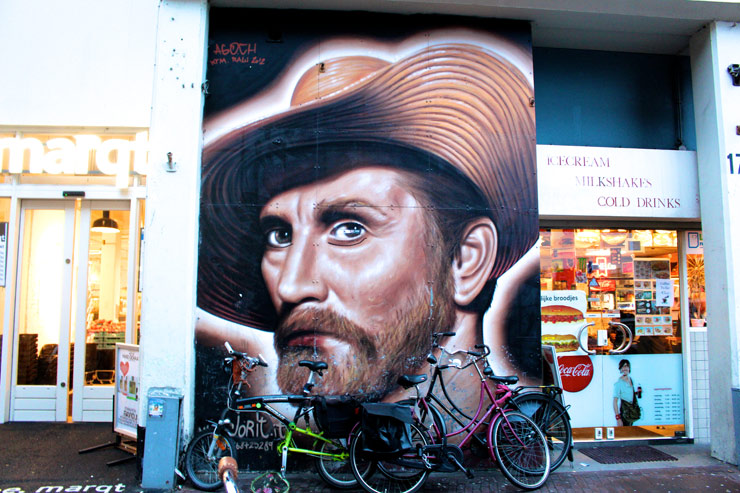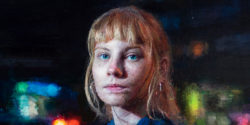It took 80 hours and 7 humid sticky days and nights to complete, longer than it took God to make Heaven and Earth, according to scriptures. But the powerful transformation of the famed Houston Street Wall that took place last week had as profound an effect on many New York fans of Street Art and Graffiti as the melting of the North and South poles. And that was probably intentional.

Revok and Pose. Houston/Bowery Wall. June 2013, NYC. (Photo © Jaime Rojo)
The resulting flash flooding of emotions and summer storms washed over LA’s Revok and Chicago’s Pose as they joined each other with other MSK brothers to create a feast of popping color, styles, texture, tribute, and pure character – each climbing and gripping tightly to one another on a 90 degree diagonal grid that pushed it all together in one riotous composition.
Ultimately, the visually cacophonic mural, born amidst endless honking, screeching, sirens and a parade of curious passersby who pummeled the painters with a fusillade of questions and requests, is a joyous compilation for many, a perplexing mix of influences for others. With layers of tributes to fallen graffiti writers, shout-outs to friends and family, and heartfelt thanks to the host city that sparked a global graffiti scene decades earlier (including this very spot), the visiting thirty something graffiti brothers couldn’t quite quantify the depth of feeling they were experiencing as they slowly smashed a big wall in the heart of Manhattan.

Revok and Pose. Houston/Bowery Wall. June 2013, NYC. (Photo © Jaime Rojo)
For New York fans of a wall made famous by a long list of Street Artists including Haring, Scharf, Fairey, Faile, and others, most on the street hadn’t heard the names of these new guys but, like true New Yorkers, welcomed them nonetheless, usually emphatically. If there were worries about a strict adherence to rules of graffiti culture or whether the work borrows some conventions from pop, advertising, graphic design, or even Street Art, not many appeared to care about those distinctions. If anything, this wall is the apt expression of today’s’ blurred lines, where a throwie, a Lichtenstein, a sharply abstract pattern, and a hungry gorilla salivating over a police cruiser can all coexist harmoniously.

Revok and Pose. Houston/Bowery Wall. June 2013, NYC. (Photo © Jaime Rojo)
In fact it appears that Revok and Pose are metaphorically and technically casting aside once and for all the artificial divisions on the streets when it comes to styles and methods. Whether its the joint gallery shows, collaborative outdoor art festivals, or institutional venues like the sweeping “Art in the Streets” exhibit at MoCA a couple of years ago, it looks like graffiti and Street Art have been put into a room and encouraged to work out their differences. Now of course they’re copying off each others exam paper in the back row of class, but at least they’re not fighting so much. Okay, true, that announcement is still premature, but you can see the horizon ahead. Naturally in a city like New York that often typifies global diversity and routinely gives wide latitude for freedom of expression, the creative spirit as expressed with such technical skill and this kind of whole-hearted passion is invariably afforded a welcome. At least for a minute.

Revok and Pose. Houston/Bowery Wall. June 2013, NYC. (Photo © Jaime Rojo)
But that didn’t mean that Pose wasn’t feeling the pressure of doing this wall well, a pressure level that he estimated at ten times more than he would feel on a typical wall, even though both guys have been graff writers for more than two decades. “We’ve all painted a million walls. This is something that is sort of a landmark and for our culture it means a lot,” he said of the involvement of contemporary graffiti artists right here, right now. “The history is very daunting because you want to honor it, you want to pay tribute, but you also want to push the boundaries by really doing your best. It’s a really insane kind of platform.”

Revok and Pose. Houston/Bowery Wall. June 2013, NYC. (Photo © Jaime Rojo)
For Revok, the LA based writer who also is spending a lot of time in Detroit these days, the opportunity brings him back to a holy place he revered growing up, and he’s not going to miss it or take it for granted. Speaking about the profound impact that New York’s’ subway artists of the 1970s and 1980s had on the imaginations of countless youth in cities around the world, Revok envisions a booming audio tower emanating concentric circles in waves traveling to all who would hear.
“I imagine it as this kind of ring that just exploded and a ripple was sent out everywhere as far as it could go – and I’m one of those receivers, I’m one of those people who felt that,” he says as he describes weaving references into the mural by including names like Dondi and Iz The Wiz and even the letter “T” from the Beat Street movie poster. “You know all of those names in there – not all of them, but a lot of them – they were New Yorkers, they were a part of that movement at that time, they were people that created this world, this idea, this language that I’ve connected to and that is so dear and important and powerful to me. And now they’re not here, they are gone.”

Revok and Pose. Houston/Bowery Wall. June 2013, NYC. (Photo © Jaime Rojo)
“But what they created and what they gave to the world will live on forever. And coming here to New York, it’s a culmination – this wall right here, there is a tremendous amount of history right here, everybody that’s done it is important in their own right. For us to be fortunate enough to be given the opportunity to do this as outsiders I feel there is a responsibility to acknowledge the people and the culture that created me and my friends and now as it is coming back home, I’m paying tribute to New York graffiti, I’m paying tribute just to the general movement as a whole,” says Revok.

Revok and Pose. Houston/Bowery Wall. June 2013, NYC. (Photo © Jaime Rojo)
Of the many references are three call outs to their recently and painfully departed MSK brother Nekst, who a handful of crew members had joined together to eulogize on smaller walls in Brooklyn the previous weekend. Among the other names included are Ayer, Vizie, Cheech Wizard, Omenz, Sace, Case 2, Semz, Tie One, Rammellzee, and “All You See is Crime in the City” – a phrase associated with a famous train car work by Skeme from the 1980s documentary “Style Wars”. The guys even did shout outs to their kids.
Aside from the art category labels and the odes to community, both Revok and Pose are doubled up on this wall because of their common regard for sampling – that is, the combining of a variety of disparate elements and re-contextualizing them. As a basis for their fine art show that just opened at Jonathan Levine Gallery while they were in the city, the two have found that they both have a fairly active studio practice that they can collaborate on also.

Revok and Pose. Houston/Bowery Wall. June 2013, NYC. (Photo © Jaime Rojo)
Both say they sample from their environment, but how they go about it is unique to each. “I sample from all the years of being on the street and climbing around. After a while you start really having an appreciation for the environment,” Revok says as he describes his affinity for textures, details, and the underlying history of the built environment.
For Pose, it may be more of an atmospheric and emotional sampling where he takes “everything from everywhere. There are no rules. It’s like “Oh that sign is gold with a white outline and that is really impressive, like that is fucking beautiful – so I should do my name that way because I’ll catch as much attention as that sign does. It’s really those rudimentary kinds of things that I feel validated by and that are where I go with my art, it’s just that basic. That’s what was powerful for me – just taking from things around you and using them to express yourself, to create a dialogue, to create a narrative.”

Revok and Pose invited Rime as a guest artists, shown here at work. Houston/Bowery Wall. June 2013, NYC. (Photo © Jaime Rojo)
A closer examination of how some of the more commercial elements in the mural were achieved by Pose shows how he used a cut and paste process in the re-purposing of old signage. Drawing from a stash of “pounce patterns” that were given to him by a buddy while he was a professional sign painter in Chicago for a decade, Pose says his method of choice is pretty randomized, and he is sometimes as surprised as anyone about what he’ll pull out. “I’ve got all these old pieces of signage rolls from this guy – these are already a slice of history. My wife hates it; my whole garage is filled with his old pounce and all this stuff. And we started bringing them to walls – almost like rolling the dice and finding this kind of completely unforeseen elements to the wall.”
With all these plans and all these cans, the guys made sure that this transformation was a collaborative effort and they had some solid support help from other MSK members, the occasional volunteer, and the well known RIME, who Revok reflexively calls, “The best graffiti writer in the world.”
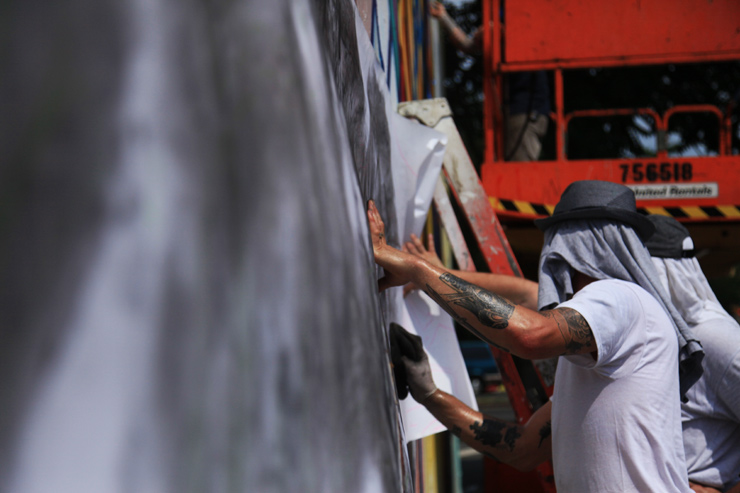
Revok and Pose. Houston/Bowery Wall. June 2013, NYC. (Photo © Jaime Rojo)
As each guy reflects on the team, the same topic of the importance of collaboration arises – a sort of progressive vision where crew members alternately work as assistants on each others projects. “We’re all really close and we play a significant role in one another’s lives and what we paint – it’s really natural for us to collaborate. I think that one of our strengths is how we feed off one another and how we motivate, influence and learn from one another. In the actual act of painting often times we work together with one kind of common goal,” explains Revok.
“We will all work together and it is all kind of a community effort to make things happen. It’s much more fun that way. I’ve been painting graffiti for 23 years now. After a certain point, just like going and painting your name all the time – it gets redundant, it gets boring. You know, you want to have fun, you want to experiment, you want to do different things. My friends and I over the last 10 years or so have really had a lot of fun experimenting and painting on a collaborative level, which is probably not that common for traditional graffiti guys. It’s a lot of fun.”

Revok and Pose. Houston/Bowery Wall. June 2013, NYC. (Photo © Jaime Rojo)
Pose agrees that collaboration was crucial in creating the new piece on the Houston Street Wall, and for him the goals were pretty clear from the beginning. “All I care about is reaching people,” he says earnestly at 4 a.m. on the fourth consecutive overnight session while sanitation trucks gather garbage from the curb. “I believe in the power of art, especially artwork that is on the street,” says the more philosophical of the duo.
“What I care about is the therapy, the unexplainable, and the powerful, and everybody in my crew, and everybody on this wall will say – ‘Graffiti saved my life’. It’s so cliché but it’s profound and it’s true. Because it is something that is really universal and it crosses so many socio-economic divides and racial divides.”
Pose pauses a beat, “Guess what, the rest of the world would be a lot better fucking place if people caught on that we are all connected.”

Revok and Pose. Houston/Bowery Wall. June 2013, NYC. (Photo © Jaime Rojo)

Revok and Pose. Houston/Bowery Wall. June 2013, NYC. (Photo © Jaime Rojo)

Revok and Pose. Houston/Bowery Wall. June 2013, NYC. (Photo © Jaime Rojo)

Revok and Pose. Houston/Bowery Wall. June 2013, NYC. (Photo © Jaime Rojo)

Revok and Pose. Houston/Bowery Wall. June 2013, NYC. (Photo © Jaime Rojo)

Revok and Pose. Houston/Bowery Wall. June 2013, NYC. (Photo © Jaime Rojo)

Revok and Pose. Houston/Bowery Wall. June 2013, NYC. (Photo © Jaime Rojo)

Revok and Pose. Houston/Bowery Wall. June 2013, NYC. (Photo © Jaime Rojo)

Revok and Pose. Houston/Bowery Wall. June 2013, NYC. (Photo © Jaime Rojo)
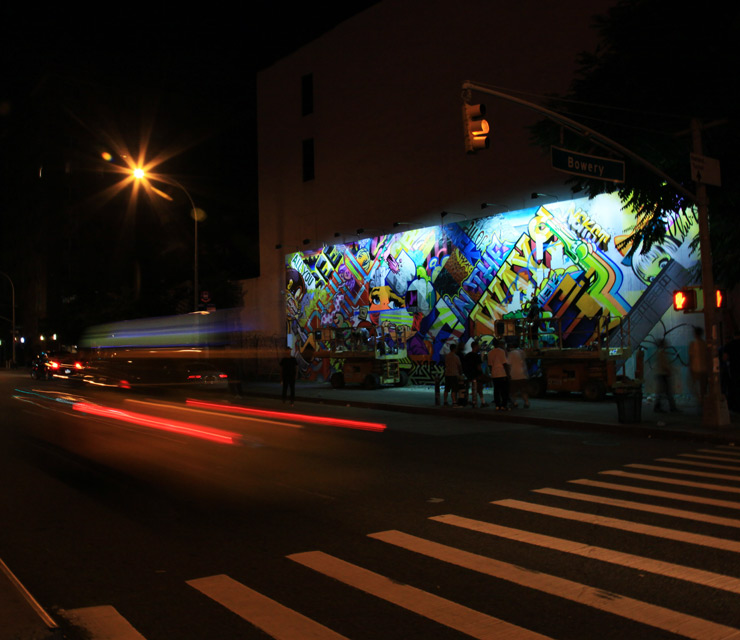
Revok and Pose. Houston/Bowery Wall. June 2013, NYC. (Photo © Jaime Rojo)

Revok and Pose. Houston/Bowery Wall. June 2013, NYC. (Photo © Jaime Rojo)

Revok and Pose. Houston/Bowery Wall. June 2013, NYC. (Photo © Jaime Rojo)

Revok and Pose. Houston/Bowery Wall. June 2013, NYC. (Photo © Jaime Rojo)

Revok and Pose. Houston/Bowery Wall. June 2013, NYC. (Photo © Jaime Rojo)
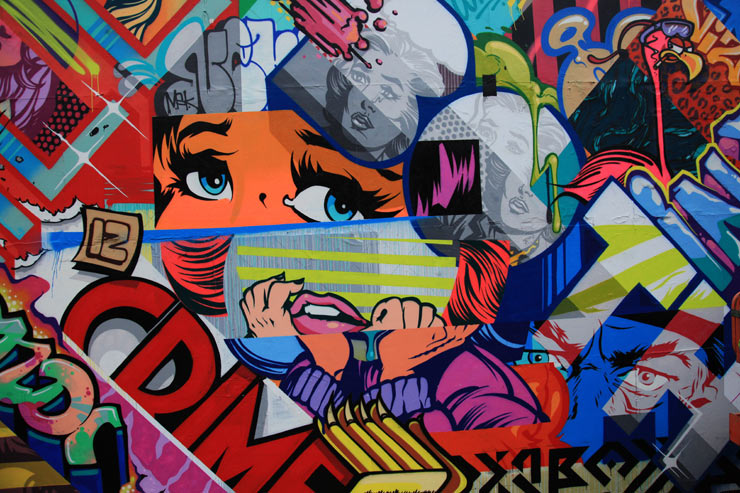
Revok and Pose. Houston/Bowery Wall. June 2013, NYC. (Photo © Jaime Rojo)

Revok and Pose. Houston/Bowery Wall. June 2013, NYC. (Photo © Jaime Rojo)

Revok and Pose. BSA is in the house. Houston/Bowery Wall. June 2013, NYC. (Photo © Jaime Rojo)

Revok and Pose. Houston/Bowery Wall. June 2013, NYC. (Photo © Jaime Rojo)

The talented crew. From left to right Pose with his assistant Mike, Revok with his assistant Travis. Props to Travis and Mike for unflinchingly supporting the artists. Houston/Bowery Wall. June 2013, NYC. (Photo © Jaime Rojo)

Revok and Pose. Houston/Bowery Wall. June 2013, NYC. (Photo © Jaime Rojo)
You can check out the Revok and Pose transformation for free all summer in NYC at the corner of Houston and Bowery.
Special thanks to Travis and Mike, Meghan Coleman, Martha Cooper, Jonathan Levine, Alix Frey, Maléna Seldin, Roger Gastman, and all the great New Yorkers we met on the streets last week.
Check out the REVOK and POSE exhibition “Uphill Both Ways” at the Jonathan Levine Gallery.
<<>>><><<>BSA<<>>><<<>><><BSA<<>>><><<>BSA<<>>><<<>><><BSA
Please note: All content including images and text are © BrooklynStreetArt.com, unless otherwise noted. We like sharing BSA content for non-commercial purposes as long as you credit the photographer(s) and BSA, include a link to the original article URL and do not remove the photographer’s name from the .jpg file. Otherwise, please refrain from re-posting. Thanks!
<<>>><><<>BSA<<>>><<<>><><BSA<<>>><><<>BSA<<>>><<<>><><BSA
This posting also appears on The Huffington Post





 BROOKLYN STREET ART LOVES YOU MORE EVERY DAY
BROOKLYN STREET ART LOVES YOU MORE EVERY DAY


